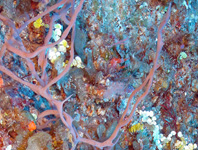Abstract
The genus Hymeraphia currently comprises three species and all records of the genus are from the northeast Atlantic and the Mediterranean Sea. The present paper describes a new species, H. vaceleti sp. nov. from a deep-water canyon, off southwest Ireland. H. vaceleti sp. nov. is morphologically distinct from other Hymeraphia species and 28S rRNA sequences show substantial differences between our new species and other Hymeraphia spp. We present data on the prevalence of sponge species established on the basis of single specimens (singletons) or uniques (species only known from a single locality). We argue for the recognition of singletons for species that are rare or from habitats that are very difficult to survey or sample, such as the deep sea.
References
Cárdenas, P., Rapp, H.T., Schander, C. & Tendal, O.S. (2010) Molecular taxonomy and phylogeny of the Geodiidae (Porifera, Demospongiae, Astrophorida)—combining phylogenetic and Linnaean classification. Zoologica Scripta, 39 (1), 89–106.
https://doi.org/10.1111/j.1463-6409.2009.00402.xDayrat, B. (2005) Towards integrative taxonomy. Biological Journal of the Linnean Society, 85, 407–415.
https://doi.org/10.1111/j.1095-8312.2005.00503.xHebert, P.D.N., Cywinska, A., Ball, S.L. & deWaard, J.R. (2003) Biological identifications through DNA barcodes. Proceedings of the Royal Society of London, 270, 313–321.
https://doi.org/10.1098/rspb.2002.2218Hooper, J.N.A. (2002) Family Raspailiidae Hentschel, 1923. In: Hooper, J.N.A. & Van Soest, R.W.M. (Eds.), Systema Porifera. Guide to the classification of sponges. Kluwer Academic/Plenum Publishers, New York, Boston, Dordrecht, London and Moscow, pp. 469–510.
https://doi.org/10.1007/978-1-4615-0747-5-53Katoh, K., Misawa, K., Kuma, K. & Miyata, T. (2002) MAFFT: a novel method for rapid multiple sequence alignment based on fast Fourier transform. Nucleic Acids Research, 30, 3059–3066.
https://doi.org/10.1093/nar/gkf436Kearse, M., Moir, R., Wilson, A., Stones-Havas, S., Cheung, M., Sturrock, S., Buxton, S., Cooper, A., Markowitz, S., Duran, C., Thierer, T., Ashton, B., Mentjies, P. & Drummond, A. (2012) Geneious Basic: an integrated and extendable desktop software platform for the organization and analysis of sequence data. Bioinformatics, 28 (12), 1647–1649.
https://doi.org/10.1093/bioinformatics/bts199Lavrov, D.V., Forget, L., Kelly, M. &Lang, B.F. (2005) Mitochondrial genomes of two demosponges provide insights into an early stage of animal evolution. Molecular Biology and Evolution, 22, 1231–1239.
Lim, G.S., Balke, M. & Meier, R. (2012) Determining Species Boundaries in a world Full of Rarity: Singletons, Species Delimitation Methods. Systematic Biology, 61, 165–169.
https://doi.org/10.1093/sysbio/syr030Morrow, C., Picton, B., Erpenbeck, D., Boury-Esnault, N., Maggs, C. & Allcock, A.L. (2012) Congruence between nuclear and mitochondrial genes in Demospongiae: A new hypothesis for relationships within the G4 clade (Porifera: Demospongiae). Molecular Phylogenetics and Evolution, 62 (1), 174–190.
https://doi.org/10.1016/j.ympev.2011.09.016Morrow, C. & Cárdenas, P. (2015) Proposal for a revised classification of the Demospongiae (Porifera). Frontiers in Zoology, 12, 7.
https://doi.org/10.1186/s12983-015-0099-8
O’Meara, B.C. (2010) New heuristic methods for joint species delimitation and species tree inference. Systematic Biology, 59, 59–73.
https://doi.org/10.1093/sysbio/syp077Petersen, F.T., Damgaard, J. & Meier, R. (2007) DNA taxonomy: how many DNA sequences are needed for solving a taxonomic problem? The case of two parapatric species of louse flies (Diptera: Hippoboscidae: Ornithomya Latreille, 1802). Arthropod Systematics & Phylogeny, 65, 119–125.
Picton, B.E. & Goodwin, C.E. (2007) Sponge biodiversity of Rathlin Island, Northern Ireland. Journal of the Marine Biological Association of the United Kingdom, 87 (6), 1441–1458.
https://doi.org/10.1017/S0025315407058122Ratnasingham, S. & Hebert, P.D.N. (2007) BOLD: the Barcode of life data system (www.barcodinglife.org). Molecular Ecology Notes, 7, 355–364.
https://doi.org/10.1111/j.1471-8286.2007.01678.xRonquist, F. & Huelsenbeck, J.P. (2003) MrBayes 3: Bayesian phylogenetic inference under mixed models. Bioinformatics, 19, 1572–1574.
https://doi.org/10.1093/bioinformatics/btg180Sarà, M. & Siribelli, L. (1960) La fauna di Poriferi delle ‘secche’ del Golfo di Napoli. 1. La ‘secca’ della Gaiola. Annuario dell’Istituto e Museo de Zoologia dell’Università di Napoli, 12 (3), 1–93.
Stamatakis, A. (2014) RAxML Version 8: A tool for Phylogenetic Analysis and Post- Analysis of Large Phylogenies. Bioinformatics, 30 (9), 1312–1313.
https://doi.org/10.1093/bioinformatics/btu033Vacelet, J. (2006) New carnivorous sponges (Porifera, Poecilosclerida) collected from manned submersibles in the deep Pacific. Zoological Journal of the Linnean Society, 148, 553–584.
https://doi.org/10.1111/j.1096-3642.2006.00234.xVan Soest, R.W.M., Boury-Esnault, N., Hooper, J.N.A., Rützler, K., de Voogd, N.J., Alvarez, B., Hajdu, E., Pisera, A.B., Manconi, R., Schönberg, C., Klautau, M., Picton, B., Kelly, M., Vacelet, J., Dohrmann, M., Díaz, M.-C., Cárdenas, P., Carballo, J.L., Ríos, P. & Downey, R. (2018) World Porifera Database. Accessed from: http://www.marinespecies.org/porifera (accessed 13 April 2018)
Wörheide, G. (2005) Low variation in partial cytochrome oxidase subunit I (COI) mitochondrial sequences in the coralline demosponge Astrosclera willeyana across the Indo-Pacific. Marine Biology, 148 (5), 907–912.
https://doi.org/10.1007/s00227-005-0134-y

